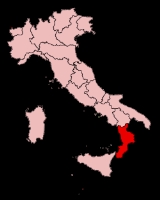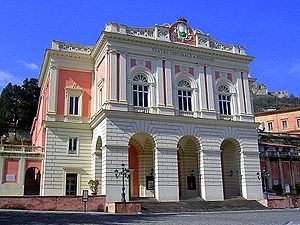
Music of Calabria
Encyclopedia
The music of Calabria is part of the Italian musical tradition
. Like other regions in southern Italy, Calabria
for many centuries was an integral part of the kingdom of Naples
, and, as with other regions, the musical life tended to be overshadowed by the important activities in the capital city to the north—the conservatories there, the composers, the vast amount of music performed in churches (see also Music of Naples
). Yet, modern Calabria has developed a vibrant musical life based on its history and, as well, a dedication to building new musical and theatrical facilities, many of which are of the type termed polivalenti in Italian—that is, multi-purpose.
 The rural Calabrian folk tradition is most closely associated with the zampogna
The rural Calabrian folk tradition is most closely associated with the zampogna
, the Italian bagpipe, which is found across Italy but is an especially important part of the Calabrian tradition. Calabria is home to at least five different kinds of zampogna. This tradition has lately been recorded and adapted by the group Re Niliu. There is also an ancient Calabrian lira
(violin
) tradition.
's version of Aida
as well as productions of Rigoletto
. There is a secondary theater, the Teatro Masciari, once famous as a vaudeville
house; after the inevitable post-war decline it has known a modern rebirth as a multi-purpose facility.
 The Teatro Rendano, in Cosenza
The Teatro Rendano, in Cosenza
, is the only truly traditional theater in Calabria. It was built in 1909, severely damaged by the aerial bombardments of World War II
, closed, rebuilt and finally reopened. It has a reputation for fine acoustics and being a beautiful venue for performers and audiences alike. Two associations are connected with the very active performance schedule: the Associazione Quintieri and Associazone Jonica. The city is the site of the Stanislao Giocamantonio music conservatory, housed on the premises of the old Santa Maria delle Grazie convent.
Particularly given to emphasizing its Greek history (it was the site of the ancient academy of Pythagoras
), Crotone
takes advantage of some impressive archaeology as venues for music. Best-known is the Aurora Festival on the grounds of the ancient temple
of Hera
Licinia, which featured a festival dedicated to the music of Greek composer Mikis Theodorakis
.
The Teatro Comunale Cilea of Reggio di Calabria was built in 1818 and was originally one of the great royal opera houses in the Kingdom of Naples
. It was severely damaged by the devastating earthquake of 1908 and again by bombing in World War II. It has since been rebuilt and reopened and pursues an active operatic schedule. The city is also the site of the Francesco Cilea
music conservatory, named for the "favorite son" composer.
The Fausto Torrefranca music conservatory is located in Vibo Valentia
. The Solisti Calabri is an active chamber music ensemble, and the Cilea Association sponsors regular concerts.
Music of Italy
The music of Italy ranges across a broad spectrum of opera and instrumental classical music and a body of popular music drawn from both native and imported sources. Music has traditionally been one of the cultural markers of Italian national and ethnic identity and holds an important position in...
. Like other regions in southern Italy, Calabria
Calabria
Calabria , in antiquity known as Bruttium, is a region in southern Italy, south of Naples, located at the "toe" of the Italian Peninsula. The capital city of Calabria is Catanzaro....
for many centuries was an integral part of the kingdom of Naples
Naples
Naples is a city in Southern Italy, situated on the country's west coast by the Gulf of Naples. Lying between two notable volcanic regions, Mount Vesuvius and the Phlegraean Fields, it is the capital of the region of Campania and of the province of Naples...
, and, as with other regions, the musical life tended to be overshadowed by the important activities in the capital city to the north—the conservatories there, the composers, the vast amount of music performed in churches (see also Music of Naples
Music of Naples
Naples has played an important and vibrant role over the centuries not just in the music of Italy, but in the general history of western European musical traditions. This influence extends from the early music conservatories in the 16th century through the music of Alessandro Scarlatti during the...
). Yet, modern Calabria has developed a vibrant musical life based on its history and, as well, a dedication to building new musical and theatrical facilities, many of which are of the type termed polivalenti in Italian—that is, multi-purpose.
Folk music

Zampogna
Zampogna is a generic term for a number of Italian double chantered pipes that can be found as far north as the southern part of the Marche, throughout areas in Abruzzo, Latium, Molise, Basilicata, Campania, Calabria, and Sicily...
, the Italian bagpipe, which is found across Italy but is an especially important part of the Calabrian tradition. Calabria is home to at least five different kinds of zampogna. This tradition has lately been recorded and adapted by the group Re Niliu. There is also an ancient Calabrian lira
Lira
Lira is the name of the monetary unit of a number of countries, as well as the former currency of Italy, Malta, San Marino and the Vatican City and Israel. The term originates from the value of a Troy pound of high purity silver. The libra was the basis of the monetary system of the Roman Empire...
(violin
Violin
The violin is a string instrument, usually with four strings tuned in perfect fifths. It is the smallest, highest-pitched member of the violin family of string instruments, which includes the viola and cello....
) tradition.
Musical and theatrical facilities
Catanzaro's Teatro Politeama is a new version (2002) of an older theater. It is run by the Catanzaro Foundation for the Politeama Theater and is solidly dedicated to continuing a great operatic tradition. They have already staged Franco ZeffirelliFranco Zeffirelli
Franco Zeffirelli KBE is an Italian director and producer of films and television. He is also a director and designer of operas and a former senator for the Italian center-right Forza Italia party....
's version of Aida
Aida
Aida sometimes spelled Aïda, is an opera in four acts by Giuseppe Verdi to an Italian libretto by Antonio Ghislanzoni, based on a scenario written by French Egyptologist Auguste Mariette...
as well as productions of Rigoletto
Rigoletto
Rigoletto is an opera in three acts by Giuseppe Verdi. The Italian libretto was written by Francesco Maria Piave based on the play Le roi s'amuse by Victor Hugo. It was first performed at La Fenice in Venice on March 11, 1851...
. There is a secondary theater, the Teatro Masciari, once famous as a vaudeville
Vaudeville
Vaudeville was a theatrical genre of variety entertainment in the United States and Canada from the early 1880s until the early 1930s. Each performance was made up of a series of separate, unrelated acts grouped together on a common bill...
house; after the inevitable post-war decline it has known a modern rebirth as a multi-purpose facility.

Cosenza
Cosenza is a city in southern Italy, located at the confluence of two historic rivers: the Busento and the Crathis. The municipal population is of around 70,000; the urban area, however, counts over 260,000 inhabitants...
, is the only truly traditional theater in Calabria. It was built in 1909, severely damaged by the aerial bombardments of World War II
World War II
World War II, or the Second World War , was a global conflict lasting from 1939 to 1945, involving most of the world's nations—including all of the great powers—eventually forming two opposing military alliances: the Allies and the Axis...
, closed, rebuilt and finally reopened. It has a reputation for fine acoustics and being a beautiful venue for performers and audiences alike. Two associations are connected with the very active performance schedule: the Associazione Quintieri and Associazone Jonica. The city is the site of the Stanislao Giocamantonio music conservatory, housed on the premises of the old Santa Maria delle Grazie convent.
Particularly given to emphasizing its Greek history (it was the site of the ancient academy of Pythagoras
Pythagoras
Pythagoras of Samos was an Ionian Greek philosopher, mathematician, and founder of the religious movement called Pythagoreanism. Most of the information about Pythagoras was written down centuries after he lived, so very little reliable information is known about him...
), Crotone
Crotone
Crotone is a city and comune in Calabria, southern Italy, on the Ionian Sea. Founded circa 710 BC as the Achaean colony of Croton , it was known as Cotrone from the Middle Ages until 1928, when its name was changed to the current one. In 1994 it became the capital of the newly established...
takes advantage of some impressive archaeology as venues for music. Best-known is the Aurora Festival on the grounds of the ancient temple
Greek temple
Greek temples were structures built to house deity statues within Greek sanctuaries in Greek paganism. The temples themselves did usually not directly serve a cult purpose, since the sacrifices and rituals dedicated to the respective deity took place outside them...
of Hera
Hera
Hera was the wife and one of three sisters of Zeus in the Olympian pantheon of Greek mythology and religion. Her chief function was as the goddess of women and marriage. Her counterpart in the religion of ancient Rome was Juno. The cow and the peacock were sacred to her...
Licinia, which featured a festival dedicated to the music of Greek composer Mikis Theodorakis
Mikis Theodorakis
Mikis Theodorakis is one of the most renowned Greek songwriters and composers. Internationally, he is probably best known for his songs and for his scores for the films Zorba the Greek , Z , and Serpico .Politically, he identified with the left until the late 1980s; in 1989, he ran as an...
.
The Teatro Comunale Cilea of Reggio di Calabria was built in 1818 and was originally one of the great royal opera houses in the Kingdom of Naples
Kingdom of Naples
The Kingdom of Naples, comprising the southern part of the Italian peninsula, was the remainder of the old Kingdom of Sicily after secession of the island of Sicily as a result of the Sicilian Vespers rebellion of 1282. Known to contemporaries as the Kingdom of Sicily, it is dubbed Kingdom of...
. It was severely damaged by the devastating earthquake of 1908 and again by bombing in World War II. It has since been rebuilt and reopened and pursues an active operatic schedule. The city is also the site of the Francesco Cilea
Francesco Cilea
Francesco Cilea was an Italian composer. Today he is particularly known for his operas L'arlesiana and Adriana Lecouvreur.-Biography:...
music conservatory, named for the "favorite son" composer.
The Fausto Torrefranca music conservatory is located in Vibo Valentia
Vibo Valentia
Vibo Valentia is a city and comune in the Calabria region of southern Italy, near the Tyrrhenian Sea. It is the capital of the province of Vibo Valentia, and is an agricultural, commercial and tourist center . There are also several large manufacturing industries, including the tuna district of...
. The Solisti Calabri is an active chamber music ensemble, and the Cilea Association sponsors regular concerts.

